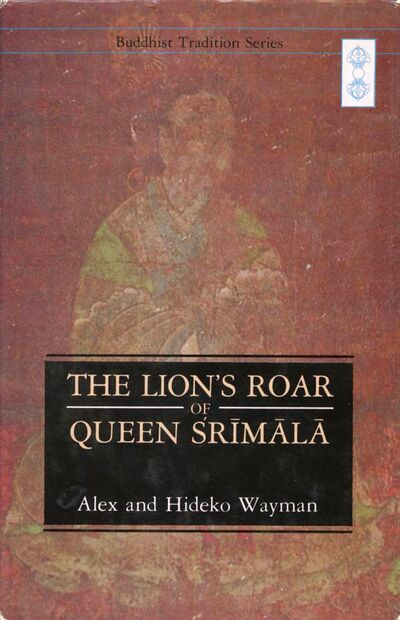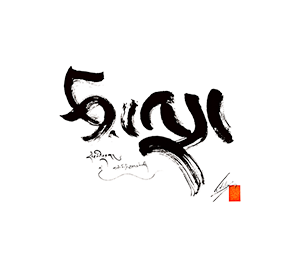- Forewordvii
- Prefacexiii
- Translators' Notexv
- Introduction1
- I. Śrī-Mālā as a Text1
- Literary History1
- Historical Setting of the Text1
- The Title of the Scripture4
- The Text in Asian Countries5
- Importance in India5
- Importance in China9
- Importance in Japan13
- Importance in Tibet16
- The Structure of the Śrī-Mālā17
- Chapter Divisions17
- Synopsis of the Scripture21
- II. Classification of Persons24
- The Characters in the Śrī-Mālā24
- Persons on Stages26
- Stages of the "Bodies Made of Mind"29
- The Last Three Bodhisattva Stages33
- Stages of the Lady Bodhisattva35
- III. Doctrine of Śrī-Mālā37
- Vehicle and Nirvāṇa37
- One Vehicle37
- Nirvāṇa and Enlightenment39
- Tathāgatagarbha42
- The Tathāgatagarbha Theory and Scriptures42
- Synonyms and Alternate References to the Tathāgatagarbha44
- Universality of Tathāgatagarbha46
- Voidness Knowledge of the Tathāgatagarbha48
- Tathāgatagarbha and Ālayavijñāna52
- The Lion's Roar of Queen Śrīmālā57
- Prologue59
- Chapter One60
- Eliminating All Doubts60
- 1. Praises of the Infinite Merit of the Tathāgata60
- 2. Ten Great Vows64
- Eliminating All Doubts60
- Chapter Two67
- Deciding the Cause67
- 3. Three All-inclusive Aspirations67
- 4. Embrace of the Illustrious Doctrine68
- (a. Teaching in the Scope of the Great Aspirations)69
- (b. Teaching the Far-ranging Meaning)72
- (c. Teaching the Great Meaning)74
- Deciding the Cause67
- Chapter Three78
- Clarifying the Final Meaning78
- 5. One Vehicle78
- (re Vehicles of Disciples and the Self-Enlightened)78
- (re Arhats and Pratyekabuddhas)80
- ("Attended with Remainder" and "Not Final
Meaning")83 - ("Final Meaning" and "One Vehicle")89
- 6. The Boundless Noble Truths95
- 7. The Tathāgatagarbha96
- 8-9. The Dharmakāya and the Meaning of Voidness98
- 10. The One Truth100
- 11-12. The One Refuge and Wayward Stage100
- 13. Intrinsic Purity of the Mind104
- 5. One Vehicle78
- Clarifying the Final Meaning78
- Chapter Four107
- Entering the One Vehicle Path107
- 14. The True Son of the Tathāgata107
- 15. The Lion's Roar of Queen Śrīmālā109
- Entering the One Vehicle Path107
- Epilogue111
- Appendix I. The Chinese Section Titles of Śrī-Mālā and Japanese
Diagram Analyses of Four Classical Commentaries115 - Appendix II. Works Cited in Chi-tsang's Commentary125
- Glossary131
- Bibliography133
- Index139
No edit summary |
No edit summary |
||
| (14 intermediate revisions by the same user not shown) | |||
| Line 1: | Line 1: | ||
{{Book | {{Book | ||
|FullTextRead=No | |FullTextRead=No | ||
|BookToc=Foreword | |TextTranslated=Texts/Śrīmālādevīsūtra | ||
Preface xiii | |BookToc=*{{i|Foreword|vii}} | ||
Translators' Note xv | *{{i|Preface|xiii}} | ||
Introduction | *{{i|Translators' Note|xv}} | ||
I. | *{{i|Introduction|1}} | ||
Literary History | **{{i|I. Śrī-Mālā as a Text|1}} | ||
Historical Setting of the Text | **{{i| Literary History|1}} | ||
The Title of the Scripture 4 | ***{{i|Historical Setting of the Text|1}} | ||
The Text in Asian Countries | ***{{i|The Title of the Scripture|4}} | ||
Importance in India | ***{{i|The Text in Asian Countries|5}} | ||
Importance in China 9 | ****{{i|Importance in India|5}} | ||
Importance in Japan 13 | ****{{i|Importance in China|9}} | ||
Importance in Tibet 16 | ****{{i|Importance in Japan|13}} | ||
The Structure of the | ****{{i|Importance in Tibet|16}} | ||
Chapter Divisions 17 | **{{i| The Structure of the Śrī-Mālā|17}} | ||
Synopsis of the Scripture 21 | ***{{i|Chapter Divisions|17}} | ||
II. Classification of Persons 24 | ***{{i|Synopsis of the Scripture|21}} | ||
The Characters in the | **{{i|II. Classification of Persons|24}} | ||
Persons on Stages 26 | **{{i| The Characters in the Śrī-Mālā|24}} | ||
Stages of the "Bodies Made of Mind" 29 | **{{i| Persons on Stages|26}} | ||
The Last Three Bodhisattva Stages 33 | ***{{i|Stages of the "Bodies Made of Mind"|29}} | ||
Stages of the Lady Bodhisattva 35 | ***{{i|The Last Three Bodhisattva Stages|33}} | ||
III. Doctrine of | ***{{i|Stages of the Lady Bodhisattva|35}} | ||
Vehicle and | **{{i|III. Doctrine of Śrī-Mālā|37}} | ||
One Vehicle 37 | **{{i| Vehicle and Nirvāṇa|37}} | ||
****{{i|One Vehicle|37}} | |||
****{{i|Nirvāṇa and Enlightenment|39}} | |||
The | **{{i| Tathāgatagarbha|42}} | ||
Synonyms and Alternate References to the | ****{{i|The Tathāgatagarbha Theory and Scriptures|42}} | ||
Universality of | ****{{i|Synonyms and Alternate References to the Tathāgatagarbha|44}} | ||
Voidness Knowledge of the | ****{{i|Universality of Tathāgatagarbha|46}} | ||
****{{i|Voidness Knowledge of the Tathāgatagarbha|48}} | |||
The Lion's Roar of Queen | ****{{i|Tathāgatagarbha and Ālayavijñāna|52}} | ||
*{{i|The Lion's Roar of Queen Śrīmālā|57}} | |||
Prologue 59 | *{{i|Prologue|59}} | ||
Chapter One 60 | *{{i|Chapter One|60}} | ||
Eliminating All Doubts 60 | **{{i|Eliminating All Doubts|60}} | ||
1. Praises of the Infinite Merit of the | ***{{i|1. Praises of the Infinite Merit of the Tathāgata|60}} | ||
2. Ten Great Vows 64 | ***{{i|2. Ten Great Vows|64}} | ||
Chapter Two 67 | *{{i|Chapter Two|67}} | ||
Deciding the Cause 67 | **{{i|Deciding the Cause|67}} | ||
3. Three All-inclusive Aspirations 67 | ***{{i|3. Three All-inclusive Aspirations|67}} | ||
4. Embrace of the Illustrious Doctrine 68 | ***{{i|4. Embrace of the Illustrious Doctrine|68}} | ||
****{{i|(a. Teaching in the Scope of the Great Aspirations)|69}} | |||
****{{i|(b. Teaching the Far-ranging Meaning)|72}} | |||
****{{i|(c. Teaching the Great Meaning)|74}} | |||
Chapter Three 78 | *{{i|Chapter Three|78}} | ||
Clarifying the Final Meaning 78 | **{{i|Clarifying the Final Meaning|78}} | ||
5. One Vehicle 78 | ***{{i|5. One Vehicle|78}} | ||
****{{i|(''re Vehicles of Disciples and the Self-Enlightened'')|78}} | |||
****{{i|(''re Arhats and Pratyekabuddhas'')|80}} | |||
****{{i|("Attended with Remainder" and "Not Final<br>Meaning")|83}} | |||
****{{i|("Final Meaning" and "One Vehicle")|89}} | |||
6. The Boundless Noble Truths 95 | ***{{i|6. The Boundless Noble Truths|95}} | ||
7. The | ***{{i|7. The Tathāgatagarbha|96}} | ||
8-9. The | ***{{i|8-9. The Dharmakāya and the Meaning of Voidness|98}} | ||
10. The One Truth 100 | ***{{i|10. The One Truth|100}} | ||
11-12. The One Refuge and Wayward Stage 100 | ***{{i|11-12. The One Refuge and Wayward Stage|100}} | ||
13. Intrinsic Purity of the Mind 104 | ***{{i|13. Intrinsic Purity of the Mind|104}} | ||
Chapter Four 107 | *{{i|Chapter Four|107}} | ||
Entering the One Vehicle Path 107 | **{{i|Entering the One Vehicle Path|107}} | ||
14. The True Son of the | ***{{i|14. The True Son of the Tathāgata|107}} | ||
15. The Lion's Roar of Queen | ***{{i|15. The Lion's Roar of Queen Śrīmālā|109}} | ||
Epilogue | *{{i|Epilogue|111}} | ||
Appendix I. The Chinese Section Titles of | *{{i|Appendix I. The Chinese Section Titles of Śrī-Mālā and Japanese<br> Diagram Analyses of Four Classical Commentaries|115}} | ||
Japanese Diagram Analyses of Four Classical Commentaries 115 | *{{i|Appendix II. Works Cited in Chi-tsang's Commentary|125}} | ||
Appendix II. Works Cited in Chi-tsang's Commentary 125 | *{{i|Glossary|131}} | ||
Glossary 131 | *{{i|Bibliography|133}} | ||
Bibliography 133 | *{{i|Index|139}} | ||
Index 139 | |||
|AddRelatedTab=No | |AddRelatedTab=No | ||
|PublisherLogo=File:Motilal logo.png | |||
|ExtraCategories=Motilal Banarsidass Publishers | |ExtraCategories=Motilal Banarsidass Publishers | ||
|StopPersonRedirects=No | |||
}} | }} | ||
Latest revision as of 16:41, 10 August 2020
The Lion's Roar of Queen Srimala: A Buddhist Scripture on the Tathagatagarbha Theory by Alex and Hideko Wayman, published in 1974. This work is the chief scriptural authority in India for the theory that all sentient beings have the potentiality of Buddhahood. "The text treats lay Buddhism in terms of the Mahayana hero known as the bodhisattva. It presents unusual difficult problems to the translator because the original Sanskrit version no longer exists except for some citations." (Source Accessed Jan 13, 2022)
| Citation | Wayman, Alex, and Hideko Wayman, trans. The Lion's Roar of Queen Śrīmālā: A Buddhist Scripture on the Tathāgatagarbha Theory. Buddhist Tradition Series 10. Delhi: Motilal Banarsidass, 1990. First published 1974 by Columbia University Press (New York). |
|---|---|
Translation of the lost Sanskrit work made from a collation of the Chinese, Japanese, and Tibetan versions. For a full list of recensions, see the source page for the Śrīmālādevīsūtra.


